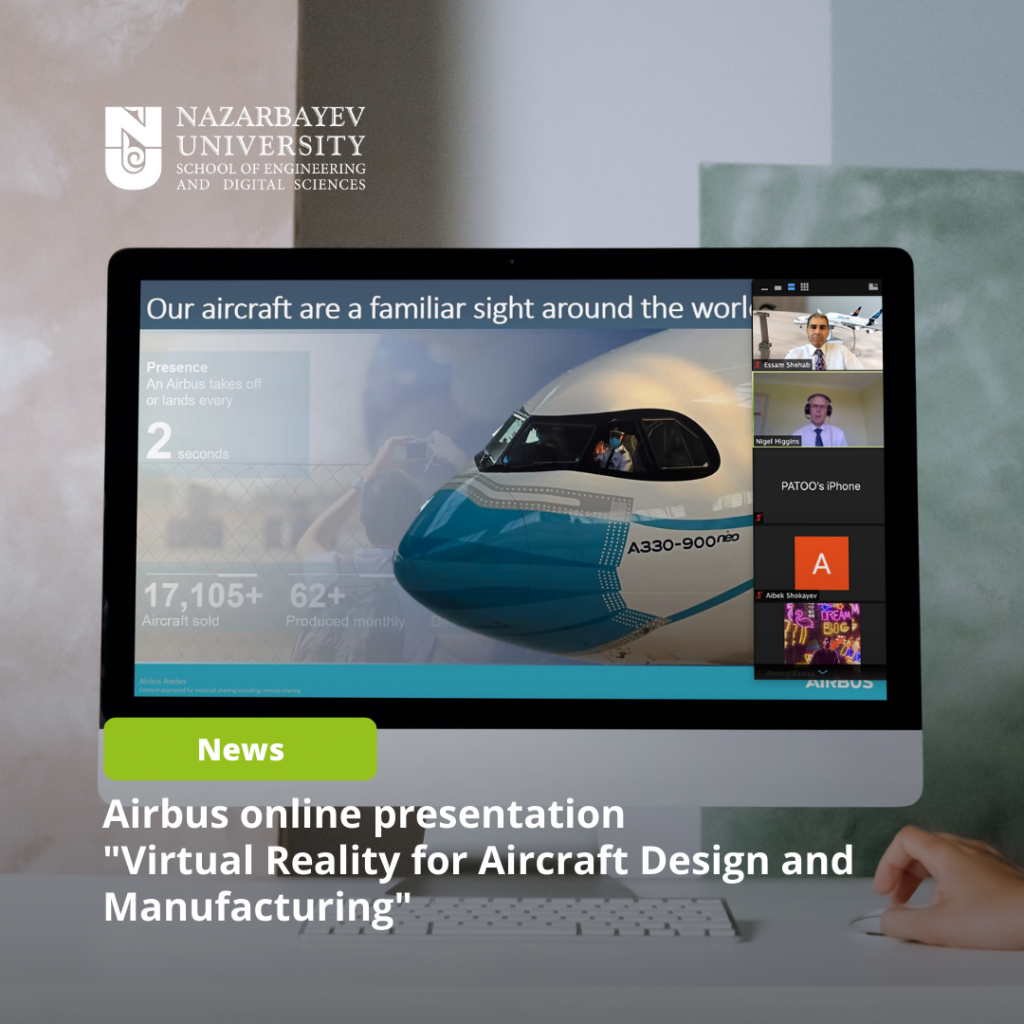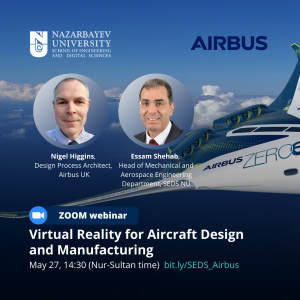Airbus online presentation “Virtual Reality for Aircraft Design and Manufacturing”

A long time the virtual reality had been considered as something fantastic and just gaming technology. But nowadays this technology is used in the different fields to solve the challenges and optimize the processes. The online presentation “Virtual Reality for Aircraft Design and Manufacturing” of Mr. Nigel Higgins from Airbus UK showed the practical use of the VR technology in one of the complex industries – in aerospace production.

Professor Essam Shehab, Head of Mechanical and Aerospace Engineering Department in the Nazarbayev University School of Engineering and Digital Sciences, organized an online talk with Mr. Nigel Higgins on how Virtual Reality is a relatively new approach to a need that has existed since the start of manufacturing aircraft and how the need for virtual reality has been brought about not only with the availability of technology but also changes to the design/manufacturing systems and the industry environment.
Mr. Nigel Higgins joined British Aerospace Commercial Aircraft Division in 1987 as a Technician apprentice. After a number of years in the structures design department working on production design he moved into the conceptual design team working on the Future Large Aircraft (flying today as A400M) and A3XX (flying today as A380).
In 1999 his career made a steer towards the Information Management side with a new role in the Knowledge Based Engineering team developing automated design systems for wing box structure. Then in 2005 formally joined the Information Management team managing the Computer Aided Design Systems across the commercial side of the business. This role developed into his current role as an architect with a number of responsibilities associated with the Product Lifecycle Management (PLM) and Visualisation Systems. Nigel is also an active STEM ambassador with Airbus supporting the Airbus stand both behind the scenes and front of house at many UK events.
Mr. Nigel Higgins talked about the importance of digitasation in the aircraft industry. In past there were multiple databases in the process, they are design – manufacturing – support, the support requires pulling many databases together. Now digitasation gives the opportunity to use all the data from different path and get the different view.
The speaker mentioned the tools that support the digitasation:
- Advanced analytics and big data
- Augmented and virtual reality
- ALM and 3D printing
- Internet of things
- Cloud services
- Social collaboration
- Mobility
- Artificial intelligence
- Augmented human’s robotics and drones
How we can see the new technologies are important in the different fields, as the digitasation is the way to improve and make a more productive process for a company.
The speaker talked about the main advantages of VR technology and has shown the practical use of the technology in Airbus company including the interface and some peculiarities.
Mr. Nigel Higgins shared the next steps of the digitasion process in aircraft design and manufacturing:
- VR system evolution,
- exploiting knowledge rather than data,
- Airbus partnership with Microsoft as a HoloLens developer announced at Paris Airshow 2019,
- improvement of technologies with parallel advances in affordability (machine learning, augmented reality etc.)
- Digital twin – data about every single aircraft
- Digital testing / simulation
And finally Mr. Nigel Higgins highlighted the main points for engineers:
- Data is critical
- Decision making different
- Collaboration department boundaries time / function merges
- Extended data with multiple path in all directions
- Continuous design loops
- Manufacturing become a data creator as well as a consumer
The presentation gathered around 60 participants from different countries –Kazakhstan, France, Egypt, Pakistan, United Arab Emirates, Nigeria, Saudi Arabia, Ghana etc. The online talk was interesting to the public, it showed the new technologies that are used in the leading aircraft producing company, the direction which will be growing and possibilities for the engineers to develop.



